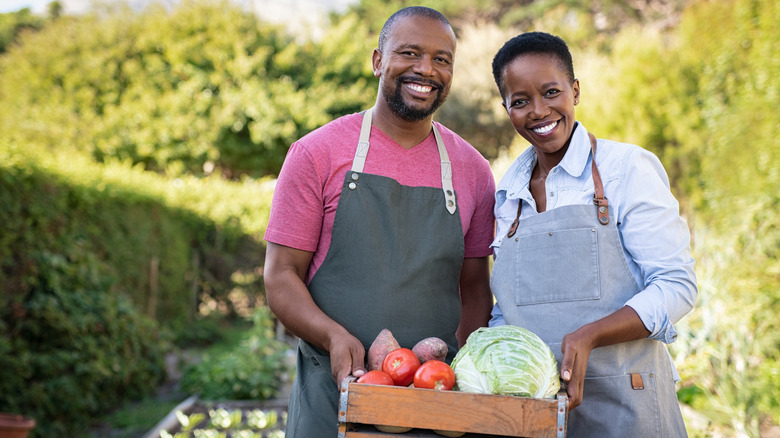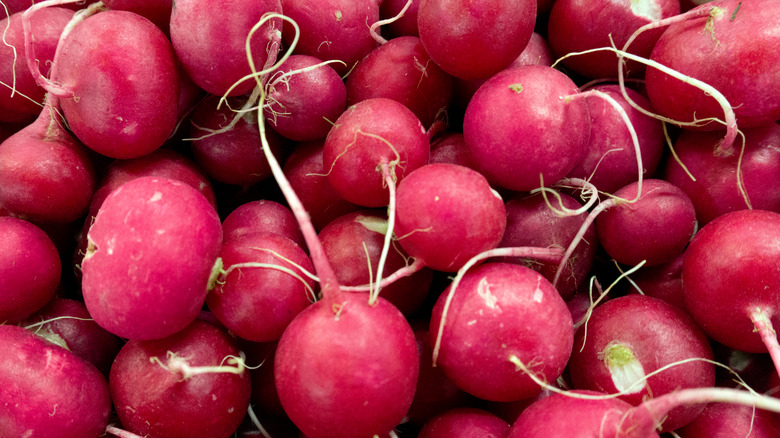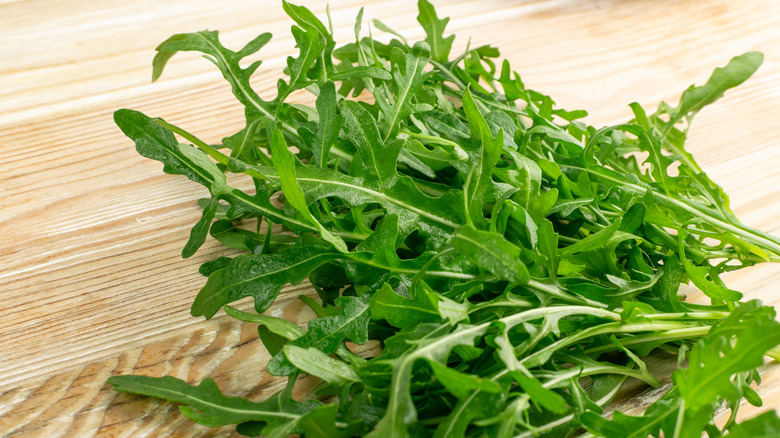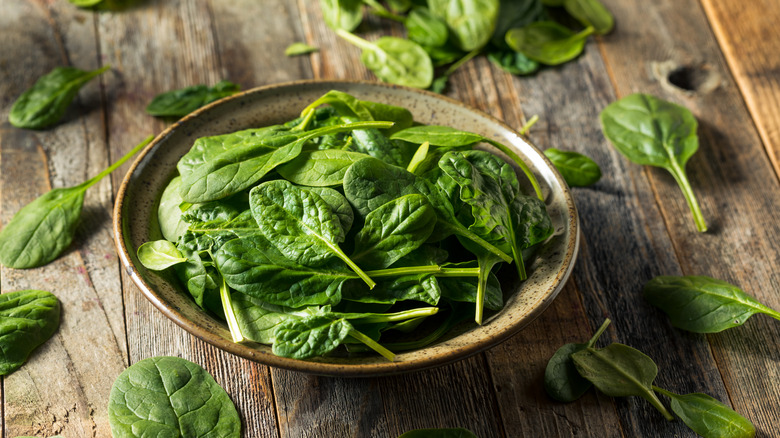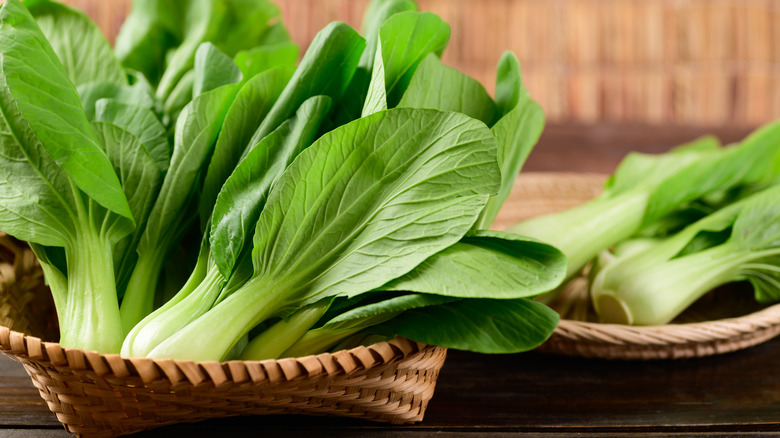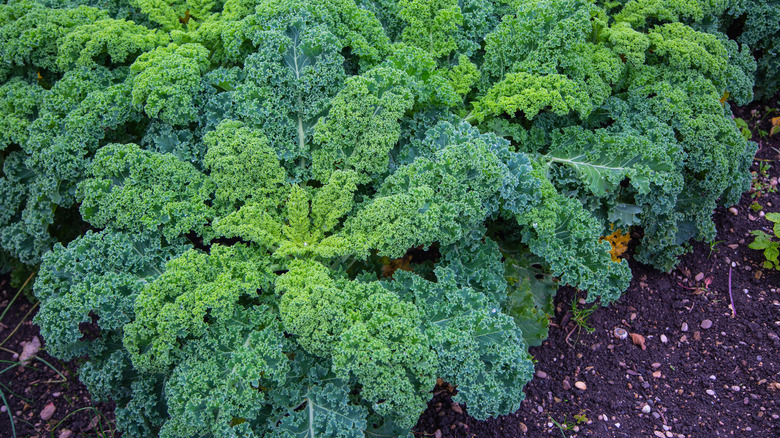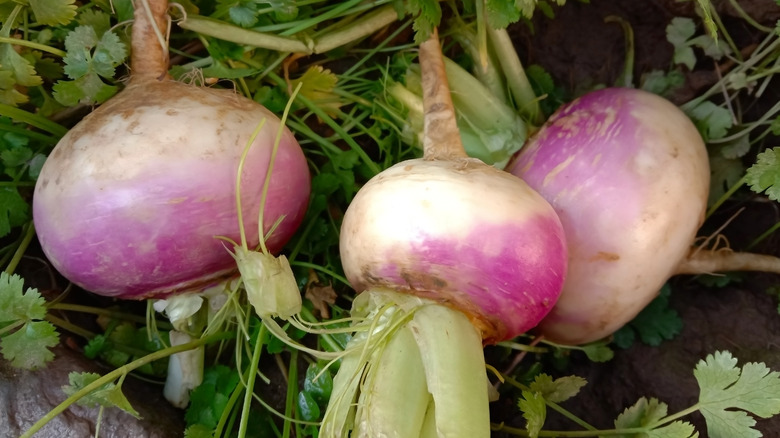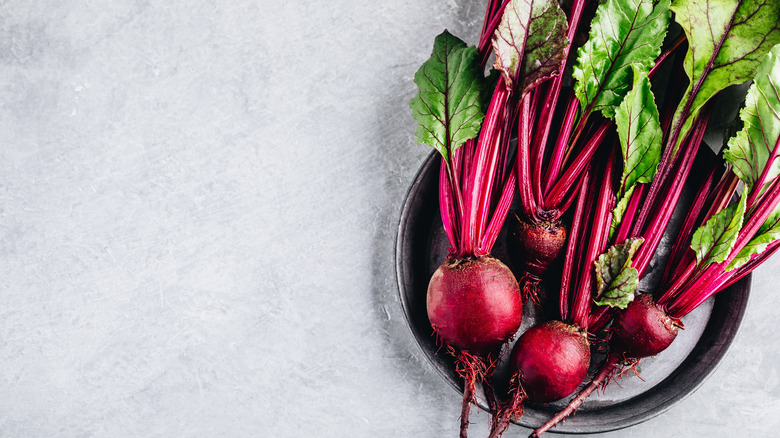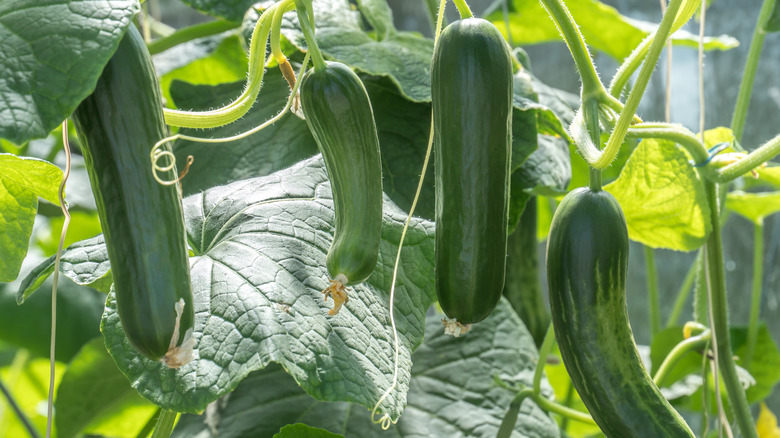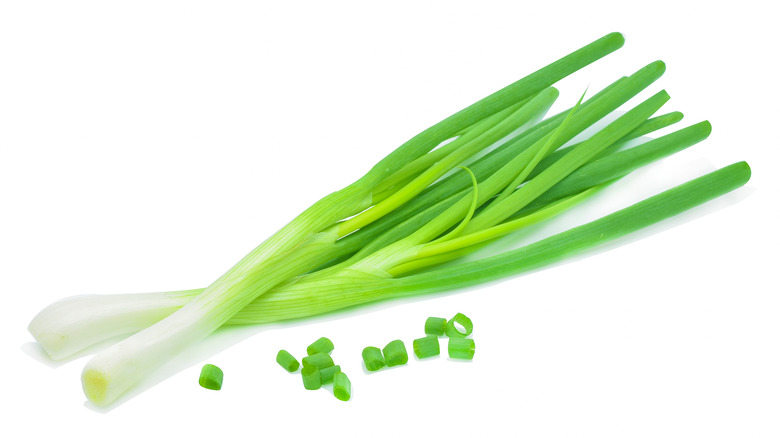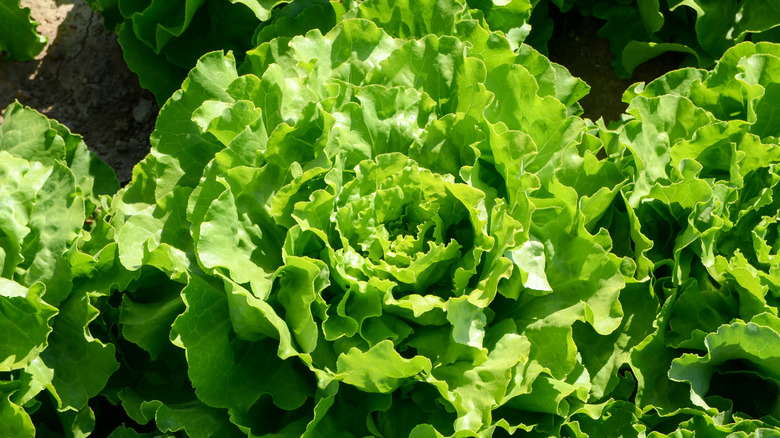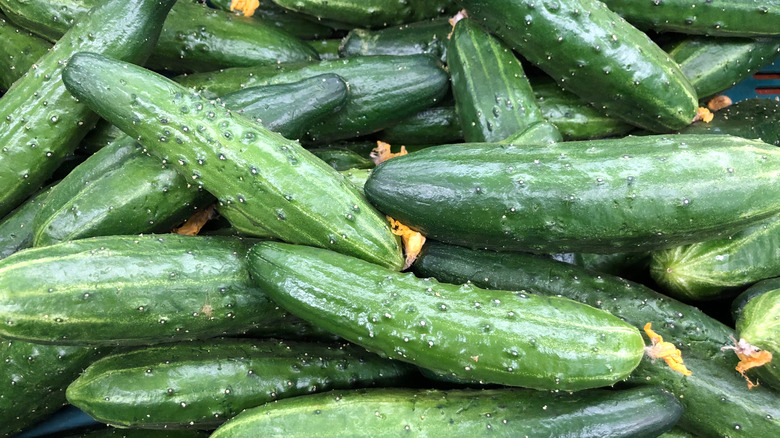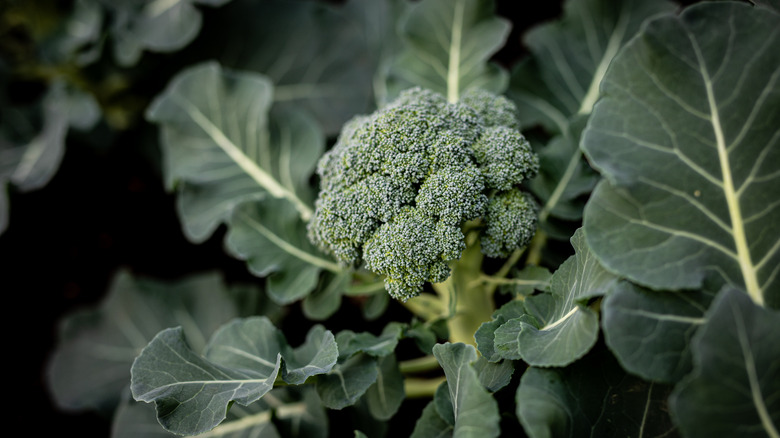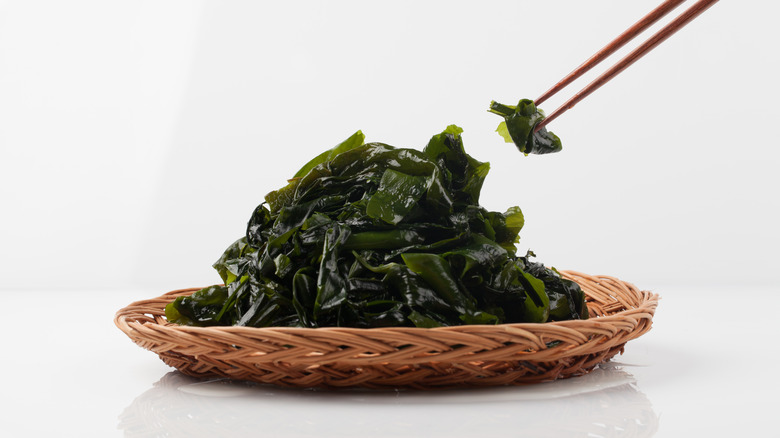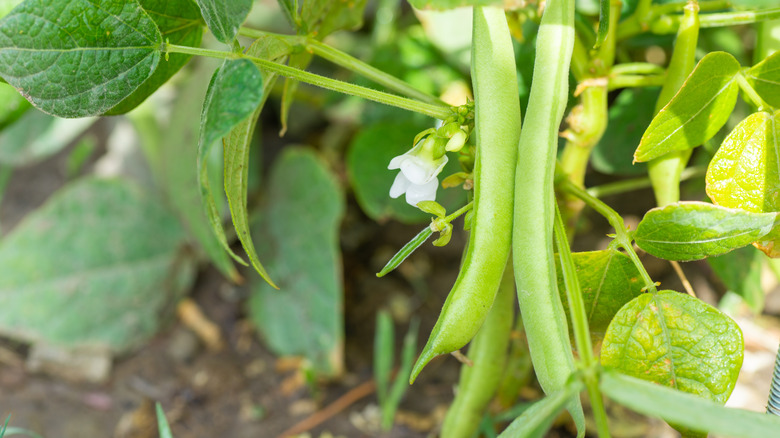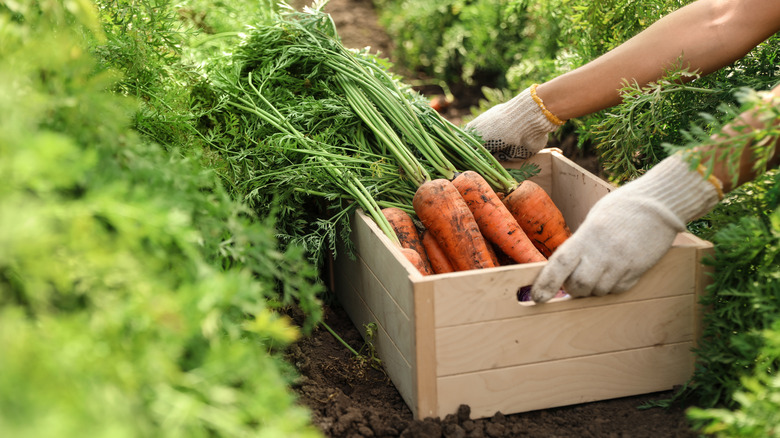15 Fastest Growing Vegetables That You'll Absolutely Love Growing
So you've decided that you want to test out your green thumb a bit and grow a small garden on your property. You have visions of rocking your favorite button-down top and black trouser combination to channel your inner Ina Garten, bringing in a basket full of beautiful vegetables, freshly picked from your little slice of paradise. You'll serve a dish incorporating your lovingly-grown vegetables to dinner party guests and passionately give their origin story if asked. Sounds pretty idyllic, no?
There are definitely a ton of benefits when it comes to growing some of your own produce, right in your backyard or on your balcony. The problem is, a lot of vegetables require not just TLC, but a whole lot of time in order to grow to the point where you can actually harvest something edible. It can certainly test your patience to watch an expanse of soil with just a few green shoots poking through, nary a vegetable in sight. Luckily, as The Micro Gardener explains, there are quite a few vegetables that grow fairly quickly. If you know that patience isn't exactly your strong suit and you want to see progress sooner rather than later, consider planting a few of these fast-growing vegetables that will yield something to harvest relatively quickly.
1. Radishes
If you're looking for almost instant gratification in your vegetable-growing quest, radishes (Raphanus sativus) just might be the perfect solution. This tasty vegetable, a crisp and lovely addition to any salad, can be harvested within three weeks of planting, and can also be planted several times in the season — you'll have more radishes than you can handle in no time, per The Old Farmer's Almanac. They need some space between themselves to allow roots to spread (via Southern Living).
Bloom Season: spring, fall
USDA Growing Zone: 6 through 11
Growing Conditions: sunny
Soil Type: loose, soft
Size: varies
2. Arugula
Arugula (Eruca vesicaria ssp. sativa) grows quite quickly, and will be ready to harvest within three to four weeks of planting the seeds, according to The Spruce. The leaves are a bit more tender and sweet when they're harvested earlier in that time window, so you can choose what type of arugula you envision for the dish you're looking to make.
Bloom Season: spring and fall
USDA Growing Zone: 3 through 11
Growing Conditions: full sun to part shade
Soil Type: moist, well-draining
Size: 6 to 12 inches
3. Spinach
If you can't get enough of green smoothies, and adore having a side salad consisting of whatever seasonal ingredients you have on hand with every meal, you just may want to consider growing spinach (spinacia oleracea), a versatile option for many gardeners, per The Old Farmer's Almanac. In order to achieve a continuous supply of the leafy green, you'll want to plant it every three weeks (via West Coast Seeds). For the tender, baby spinach leaves, you'll want to harvest your spinach when the leaves are between 3 and 4 inches long. If you wait too long to harvest, your plant can become bitter, so don't miss the ideal window for this tasty green.
Bloom Season: early spring, fall
USDA Growing Zone: 2 through 9
Growing Conditions: cool weather, full sunlight
Soil Type: rich, loamy, pH between 6 and 6.5
Size: varies
4. Bok Choy
Fans of Asian cuisine are likely familiar with bok choy (brassica rapa subsp. chinensis), a quick-growing veggie that can be harvested about 30 to 50 days after planting, making it an ideal choice for impatient gardeners, according to The Old Farmer's Store. There are a few different varieties available, and those who really want to harvest as quickly as possible may want to look for varieties like Mei Qing Choi, a dwarf boy choy variety that can be harvested in just 35 days.
Bloom Season: spring, fall
USDA Growing Zone: 2 through 11
Growing Conditions: full sun
Soil Type: rich, well-drained, consistently watered
Size: 6 to 24 inches
5. Kale
It's no secret that kale (brassica oleracea) has won the hearts of many healthy food lovers over the years, appearing in everything from green smoothies to massaged salads. It's also a perfect plant for impatient gardeners who want to see their harvest sooner rather than later, as noted by The Spruce. And, lucky for kale lovers who want a consistent supply, it's the type of vegetable that you can harvest a portion of while the plant continues to grow.
Bloom Season: early spring to mid-summer
USDA Growing Zone: 2 through 9
Growing Conditions: full sunlight
Soil Type: loamy, moist, well-draining
Size: 1 to 2 feet tall and wide
6. Turnips
Turnips (Brassica rapa subscp. rapa) don't take too long to grow, and certain varieties can be ready for harvest in 30 to 45 days, says The Micro Gardener. You do need a little bit of room for them to grow, as if they're planted closer than 4 inches apart once they pass the seedling stage, the roots can become malformed or remain small. As an added bonus, turnips are one of the vegetables that yield more than one edible component; while most people are familiar with the rounded off-white root, you're also able to eat the green portion.
Bloom Season: spring and fall
USDA Growing Zone: 2 through 0
Growing Conditions: full sunlight
Soil Type: loamy or sandy soil, with a slightly acidic to neutral pH level
Size: 12 to 14 inches
7. Beets
Beets (Beta vulgaris) are best known for their color, as they lend an incredibly vibrant hue to whatever dish they're incorporated into, and they can be grown in a wide variety of zones, as noted by The Old Farmer's Almanac. However, you want to be careful when tending young beets and doing any weeding in the area to avoid damaging the shallow roots. And, for gardeners who love to explore different parts of the vegetables they're cultivating, beets are another option with a dual purpose; you're able to eat both the colorful root as well as the green leaves on their stem.
Bloom Season: spring and fall
USDA Growing Zone: 2 through 10
Growing Conditions: full sun
Soil Type: moist, pH level above 6
Size: up to 2 feet in height
8. Zucchini
Any gardener who has dabbled in growing fruits and vegetables has likely heard tales of gardens spawning absolutely ridiculous amounts of zucchini (Cucurbita pepo), prompting the grower to whip up everything from zucchini bread to zucchini fritters in an attempt to use up the abundance of zucchini. That's because not only is zucchini a quick grower, with items ready to harvest in anywhere from 40 to 95 days, it also produces approximately 6 to 10 pounds of fruit per plant, per Off Grid World. For those interested in a bit of culinary experimentation, don't overlook the stunning flowers that are scattered amidst the oblong green zucchini — these delicate and flavorful components of the plant can be fried or even stuffed with creamy filling for a seriously gourmet dish.
Bloom Season: summer
USDA Growing Zone: 3 through 9
Growing Conditions: full sun
Soil Type: loamy, slightly acidic to neutral pH
Size: 2 to 3.5 feet
9. Scallions
While regular bulb-shaped onions take a while to harvest, if you want some of that same onion flavor on a quicker timeline, scallions (Allium wakegi) are the way to go. These thin vegetables are packed with flavor, and can actually be ready to incorporate in your dish and use while cooking in just 21 days, according to Off Grid World. One important thing to consider if you have any four-legged friends running around where you garden, however, is that they are toxic for cats and dogs, so make sure any scallions you grow are planted in a spot where your furry pals can't reach them.
Bloom Season: spring
USDA Growing Zone: 6 through 9
Growing Conditions: full sun
Soil Type: sandy, well-drained with acidic to neutral pH
Size: 1 to 3 feet tall
10. Lettuce
Is there anything that sounds better than simply popping out to your garden and grabbing a fresh head of lettuce (Lactuca sativa) for your dinner that evening? Talk about farm to table! For those looking to get a bit creative with their gardening, lettuce does grow very well in containers and raised beds.
Bloom Season: spring and fall
USDA Growing Zone: 4 through 9
Growing Conditions: full sun
Soil Type: loamy, slightly acidic to neutral pH, tilled, says The Old Farmer's Almanac
Size: 6 to 12 inches
11. Cucumbers
Cucumbers (Cucumis sativus) are a great pick for a beginner gardener just starting to learn the art of cultivating a vegetable garden; they're also ideal for impatient gardeners, as they grow quite quickly, and you're encouraged to pick them before they get too large to avoid a bitter-tasting cucumber, suggests The Old Farmer's Almanac. After being planted, you'll be able to expect fully grown cucumbers that you can slice up for salads and fresh summer dishes in just six weeks.
One thing to be aware of when purchasing your seeds is the type of cucumber plant you're looking for. Those who have a small garden, container garden, or who simply want all their vegetables grown in one area should go for bush cucumbers. Those who are looking for an abundance of cucumbers and have a trellis or fence available may want to consider vining cucumbers.
Bloom Season: summer
USDA Growing Zone: 4 through 11
Growing Conditions: full sun
Soil Type: loamy, slightly acidic to neutral pH
Size: 24 to 36 inches (bush cucumbers), 5 to 6 feet (vine cucumbers)
12. Broccoli
Broccoli (Brassica oleracea var. italica) is a nutrient-packed vegetable that can be used in a wide variety of ways, from roasted with simple salt and pepper to sautéed, or even eaten raw or shredded in a salad. And, impatient gardeners will appreciate having crowns of this tasty vegetable growing, as according to Off Grid World they can be ready to harvest within two months or less, typically able to be picked within 40 to 60 days from planting. You also want to be careful with your watering — they need consistently moist soil, but if you get the developing heads a bit too damp, they can potentially rot, so it's a fine balance.
Bloom Season: spring and fall
USDA Growing Zone: 3 through 10
Growing Conditions: full sun
Soil Type: slightly acidic to neutral pH, sandy texture
Size: 2 to 2.5 feet
13. Mustard Greens
When it comes to deciding what to plant in your garden for impatient gardeners, different types of greens are an absolute must because they grow so quickly; and, anyone who likes to mix up their greens on a regular basis should give mustard greens (Brassica juncea) a try. According to the Gardening Channel, these greens can reach maturity in as little as four to six weeks. In terms of harvesting, keep your desired recipes in mind as well — you can harvest the younger leaves for a more tender green with a more delicate flavor, while more mature leaves pack a flavorful punch and may work better sautéed or braised in dishes rather than raw.
Bloom Season: spring and fall
USDA Growing Zone: 6 through 11
Growing Conditions: full sun
Soil Type: moist, pH of 6 to 6.5
Size: 1.5 to 2 feet
14. Green Beans
Green beans (Phaseolus vulgaris) are a solid addition to any vegetable garden, especially for gardeners who want to harvest their plants sooner rather than later — they're quite easy to grow, and they produce seriously impressive amounts of crops, so you'll likely have more fresh green beans than you even know what to do with, per The Old Farmer's Almanac. The one main consideration when planting green beans is the specific type you're looking to plant, as there are two main categories: bush beans and pole beans.
Bloom Season: spring, fall
USDA Growing Zone: 3 through 10
Growing Conditions: full sun
Soil Type: clay or loamy soil with slightly acidic to neutral pH
Size: 2 feet (bush beans) or 10 to 15 feet (pole beans)
15. Carrots
Carrots (Daucus carota subsp. sativus) are an absolute staple for many vegetable lovers. Additionally, gardeners will be delighted to know that according to Gardening Know How, they can be ready to harvest within as little as two months for baby carrots, with a few extra weeks for the mature varieties. The one key consideration when growing carrots is the soil; if the soil in which you're growing your carrots has a lot of rocks or other obstructions, they can potentially impact the roots and create a less than ideal crop, warns The Old Farmer's Almanac.
Bloom Season: spring and fall
USDA Growing Zone: 3 through 10
Growing Conditions: full sun
Soil Type: loamy or sandy, neutral pH, tilled about a foot deep
Size: 6 to 12 inches
